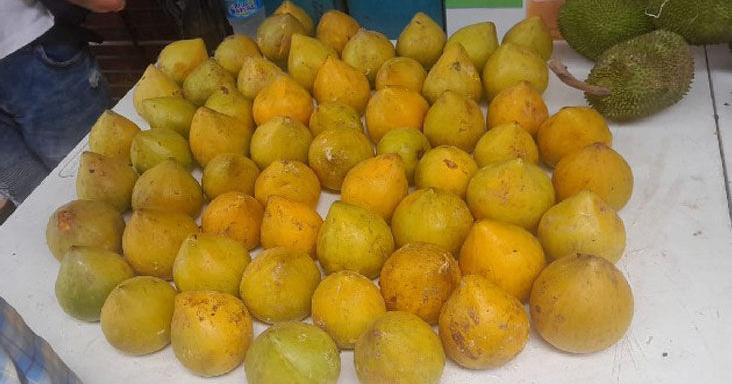Copyright trinidadexpress

“What is this?” It was a popular question among shoppers and curious passers-by on Charlotte Street, Port of Spain, on Tuesday. Right on cue, small businessman Josiah Greenidge, 37, said: “It’s an exotic fruit. It’s called ‘penna pease’ (penny piece). Some call it “egg yolk.” Dipping into a white plastic bag, his cousin Johnny Rodriguez offered people pieces of penny piece. He said: “Try it. You will like it. It tastes like a mixture of peewah and custard. Real delicious. It’s the right fix, if you have a weakness for sweetness.” A small knot of people obliged and proceeded to buy penny piece which retails at $15 and $20 each. The pear-shaped penny piece had found a place of honour on a large table. A neighbouring table was heaped with seasonal avocados, melongene, okras, green figs and mangoes. In what seemed to be a never-ending line, people continued to ask about the nature and origin of the penny piece. Some shoppers could not resist the urge to lift the precious fruit and admire its size and unique look. Looks like a pawpaw, pear-shaped at top Greenidge took to sharing information about his penny piece. He said: “It’s massive. It weighs about four to five pounds. It looks like a pawpaw below and it is pear-shaped at the top. It has a pine smell. The leaves resemble a bay leaf. It is dark green on top, and light-green below. The fruit ripens from green to a golden yellow. It has one seed and sometimes two seeds. It’s light-brown. Some people take it for a mango or a pawpaw. It is an unusual, exotic, healthy fruit.” Tree’s maiden crop More importantly, the Greenidges were celebrating the tree’s maiden crop. They paid kudos to their late grandfather Lincoln Greenidge, who lived to be 109, for bringing the seed from Africa. He said: “It’s the first time the tree bore penny piece. Since my grandfather (Lincoln Greenidge) planted it, it never bore. Now the tree is laden. There are countless fruits on the tree. It’s a big tree.” Beryl Richards recognises “penna pease” If the gentleman had to give a prize, for anybody who could have recognised the fruit, it would have gone to Diego Martin resident Beryl Richards, 80. Her eyes sparkled when she saw the fruit. She said: “Where you got penny piece from? I know this fruit. I know it when I was a child. It was small. But I have never seen penny piece so big.” Another woman popped by, and said: “ What is this? I like things like this. Give me one. In fact, give me one for my daughter. I have to try this when I get home.” Lincoln Greenidge brought penny piece to St Ann’s Greenidge claimed bragging rights that their yard at St Ann’s happens to be the “only place you can find penny piece.” He said: “We live just before the St Ann’s spring. It’s hot. Everybody likes to come there to enjoy the cool water. It’s a nice getaway.” Greenidge shared a brief history about the fruit which patriarch Greenidge brought from Africa during a visit. He said: “My grandfather got it when he went to Africa. He used to sail on the ships He brought the seed. The tree did not bear during his lifetime. He died about 15 years ago.” He added: “It’s one big tree which bears many fruits. You can’t count them. We picked about 10 boxes already. It’s the first time it bore fruit. It took years to come to maturity.” Sold about five boxes On the business venture, Greenidge said: “We brought down a box to sell in town. We did not know if it would score. Most of the elders said it is a real nice fruit. Young people were sceptical. Everybody who ate it automatically liked it. We had to meet the need. One woman came and bought two more for her son. We brought down about five boxes. There was a huge demand.” He added: “Johnny and I harvest the fruits. We use a cocoa knife and catch them in crocus bags. Then we pack them in cardboard boxes. You have to catch them before they ripen. When they are ripe, they can crack.” Greenidge said he had gleaned some life lessons about Almighty God and nature. Citing Psalms 24 verse 1, he said: “The earth is the Lord’s, and everything in it, the world, and all who live in it. I am happy to see the tree full of fruit. I thank my grandfather who brought it here. But it’s sad he never got to taste his ‘penna pease’. May he continue to rest in peace.” Penny piece/canistel • More popularly known as the eggfruit or cupcake fruit because of its shape and bright yellow colour, some people also call it canistel. • Penny piece is the fruit of the Pouteria Campechiana tree that is native to South America and Asia. • It is a cousin to Lucuma (Pouteria lucuma) which is a common Peru fruit also known as Egg fruit and also very closely related to Sapotes and Abiu. • The fruit is also called Yellow Sapote in some areas. It has a yellow, creamy pulp that can be eaten raw because of its sweet taste. • Its soft texture is comparable to a hard-boiled egg yolk. • Penny piece can also be made into a jam, marmalade, pancake, shake and even as custard for ice cream and other desserts. • There is even a popular milkshake that’s aptly named the “Eggfruit nog” because of its main ingredient, the penny pie. —Courtesy Nalis



